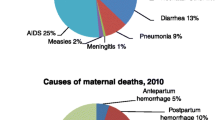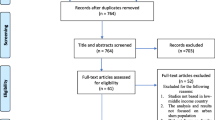Abstract
Objectives
The aim was to estimate the long-term cost-effectiveness of improved family planning interventions to reduce the unmet need in low- and middle-income countries, with Indonesia and Uganda as reference cases.
Methods
The analysis was performed using a Markov decision analytic model, where current situation and several scenarios to reduce the unmet need were incorporated as the comparative strategies. Country-specific evidence was synthesized from the demographic and health survey and published studies. The model simulated the sexual and reproductive health experience of women in the reproductive age range over a time horizon of women’s reproductive years, from the healthcare payer perspective. Modeled outcomes included clinical events, costs and incremental cost-effectiveness ratios (ICERs) expressed as cost per disability-adjusted life year (DALY) averted. Deterministic and probabilistic sensitivity analyses were conducted to assess the impact of parameter uncertainty on modeled outcomes.
Results
In the hypothetical cohort of 100,000 women, scenarios to reduce the unmet need for family planning would result in savings within a range of US$230,600–US$895,100 and US$564,400–US$1,865,900 in Indonesia and Uganda, respectively. The interventions would avert an estimated 1859–3780 and 3705–12,230 DALYs in Indonesia and Uganda, respectively. The results of our analysis indicate that scaling up family planning dominates the current situation in all scenarios in both countries, with lower costs and fewer DALYs. These results were robust in sensitivity analyses.
Conclusion
Scaling up family planning interventions could improve women’s health outcomes substantially and be cost-effective or even cost saving across a range of scenarios compared to the current situation.



Similar content being viewed by others
Data Availability Statement
All data generated or analyzed during this study are included in this published article (and its supplementary information files).
References
Alkema L, Kantorova V, Menozzi C, Biddlecom A. National, regional, and global rates and trends in contraceptive prevalence and unmet need for family planning between 1990 and 2015: a systematic and comprehensive analysis. Lancet. 2013;381:1642–52. https://doi.org/10.1016/S0140-6736(12)62204-1.
Ahmed S, Li Q, Liu L, Tsui AO. Maternal deaths averted by contraceptive use: an analysis of 172 countries. Lancet. 2012;380:111–25. https://doi.org/10.1016/s0140-6736(12)60478-4.
Prata N, Sreenivas A, Vahidnia F, Potts M. Saving maternal lives in resource-poor settings: facing reality. Health Policy. 2009;89:131–48. https://doi.org/10.1016/j.healthpol.2008.05.007.
Tsui AO, McDonald-Mosley R, Burke AE. Family planning and the burden of unintended pregnancies. Epidemiol Rev. 2010;32:152–74. https://doi.org/10.1093/epirev/mxq012.
Singh S, Darroch J, Ashford L, Vlassoff M. Adding it up: the costs and benefits of investing in family planning and maternal and newborn health. New York, NY: Guttmacher Institute and United National Population Fund; 2009.
Zakiyah N, van Asselt ADI, Roijmans F, Postma MJ, Rosen S, Vassall A. Economic evaluation of family planning interventions in low and middle income countries; a systematic review. PLoS ONE. 2016;11:e0168447. https://doi.org/10.1371/journal.pone.0168447.
Husereau D, Drummond M, Petrou S, Carswell C, Moher D, Greenberg D, et al. Consolidated Health Economic Evaluation Reporting Standards (CHEERS) statement. Value Health. 2013;16:e1–5. https://doi.org/10.1016/j.jval.2013.02.010.
Statistics Indonesia (Badan Pusat Statistik-BPS) Kementrian Kesehatan (Kemenkes- MOH), and ICF International NP and FPB (BKKBN). Indonesia Demographic and Health Survey 2012. Jakarta, Indonesia BPS, BKKBN, Kemenkes, ICF Int. 2013.
Uganda Bureau of Statistics (UBOS) and ICF International. Uganda Demographic and Health Survey 2011. Kampala, Uganda: UBOS Calverton, Maryl ICF Int Inc. 2012.
WHO. Macroeconomics and health: investing in health for economic development. Geneva: WHO; 2001.
Vemer P, Ramos IC, van Voorn GAK, Al MJ, Feenstra TL. AdViSHE: a validation-assessment tool of health-economic models for decision makers and model users. Pharmacoeconomics. 2016;34:349–61.
Trussell J. Understanding contraceptive failure. Best Pract Res Obstet Gynaecol. 2009;23:199–209. https://doi.org/10.1016/j.bpobgyn.2008.11.008.
Kennedy KI, Visness CM. Contraceptive efficacy of lactational amenorrhoea. Lancet. 1992;339:227–30. https://doi.org/10.1016/0140-6736(92)90018-X.
Van der Wijden C, Manion C. Lactational amenorrhoea method for family planning. Cochrane Database Syst Rev. 2015;10:CD001329. https://doi.org/10.1002/14651858.cd001329.pub2.
Babigumira JB, Stergachis A, Veenstra DL, Gardner JS, Ngonzi J, Mukasa-Kivunike P, et al. Potential cost-effectiveness of universal access to modern contraceptives in Uganda. PLoS ONE. 2012;7:e30735. https://doi.org/10.1371/journal.pone.0030735.
van de Kassteele J, Hoogenveen RT, Engelfriet PM, Baal PH, Boshuizen HC. Estimating net transition probabilities from cross-sectional data with application to risk factors in chronic disease modeling. Stat Med. 2012;31:533–43. https://doi.org/10.1002/sim.4423.
Indonesia National Population and Family Planning Board. Maternal health; number of pregnant women 2014. http://www.bkkbn.go.id/kependudukan/Pages/DataLainlain/Profil_kesehatan_indonesia/kesehatan_ibu/Jumlah_Ibu_Hamil/Nasional.aspx. Accessed 5 Jan 2016.
WHO. Health statistics and information systems, disease and injury estimates, burden of disease. WHO. 2016.
Kementrian Kesehatan Republik Indonesia. Standar Tarif Pelayanan Kesehatan pada Fasilitas Kesehatan Tingkat Pertama dan Fasilitas Kesehatan Tingkat Lanjutan dalam Penyelenggarakan Program Jaminan Kesehatan. Jakarta: Kementrian Kesehatan Republik Indonesia; 2014.
Babigumira JB, Stergachis A, Veenstra DL, Gardner JS, Ngonzi J, Mukasa-Kivunike P, et al. Estimating the costs of induced abortion in Uganda: a model-based analysis. BMC Public Health. 2011;11:904. https://doi.org/10.1186/1471-2458-11-904.
Levin A, Dmytraczenko T, McEuen M, Ssengooba F, Mangani R, Van Dyck G. Costs of maternal health care services in three anglophone African countries. Int J Health Plann Manage. 2003;18:3–22. https://doi.org/10.1002/hpm.690.
Black R, Laxminarayan R, Temmerman M, Walker N. Disease control priorities, 3rd edition, vol 2. Reproductive, maternal, newborn, and child health. Washington, DC: World Bank; 2016. https://doi.org/10.1596/978-1-4648-0348-2.
Horton S, Levin C. Cost-efectiveness of interventions for reproductive, maternal, neonatal, and child health. In: Disease Control Priorities, vol. 2, 3rd Edn. Reproductive, Maternal, Newborn, and Child Health. Washington, DC: World Bank; 2016. https://doi.org/10.1596/978-1-4648-0348-2ch17.
Vlassoff M, Sundaram A, Bankole A, Remez L, Mugisha F. Benefits of meeting the contraceptive needs of Ugandan women. Issues Brief (Alan Guttmacher Inst) 2009:1–8.
Hu D, Bertozzi SM, Gakidou E, Sweet S, Goldie SJ. The costs, benefits, and cost-effectiveness of interventions to reduce maternal morbidity and mortality in Mexico. PLoS ONE. 2007;2:e750. https://doi.org/10.1371/journal.pone.0000750.
Goldie SJ, Sweet S, Carvalho N, Natchu UCM, Hu D. Alternative strategies to reduce maternal mortality in India: a cost-effectiveness analysis. PLoS Med. 2010;7:e1000264. https://doi.org/10.1371/journal.pmed.1000264.
Carvalho N, Salehi AS, Goldie SJ. National and sub-national analysis of the health benefits and cost-effectiveness of strategies to reduce maternal mortality in Afghanistan. Health Policy Plan. 2013;28:62–74. https://doi.org/10.1093/heapol/czs026.
Erim DO, Resch SC, Goldie SJ. Assessing health and economic outcomes of interventions to reduce pregnancy-related mortality in Nigeria. BMC Public Health. 2012;12:786. https://doi.org/10.1186/1471-2458-12-786.
Mohllajee AP, Curtis KM, Morrow B, Marchbanks PA. Pregnancy intention and its relationship to birth and maternal outcomes. Obstet Gynecol. 2007;109:678–86. https://doi.org/10.1097/01.AOG.0000255666.78427.c5.
Sedgh G, Ball H. Abortion in Indonesia. Issues Brief (Alan Guttmacher Inst). 2008;2:1–6.
Briggs A, Sculpher M, Claxton K. Decision modelling for health economic evaluation. Oxford: OUP; 2006.
Horton R, Peterson HB. The rebirth of family planning. Lancet. 2012;380:77. https://doi.org/10.1016/s0140-6736(12)61026-5.
Peterson HB, Darmstadt GL, Bongaarts J. Meeting the unmet need for family planning: now is the time. Lancet. 2013;381:1696–9. https://doi.org/10.1016/s0140-6736(13)60999-x.
UN. Transforming our world: the 2030 Agenda for Sustainable Development 2015;2017. https://sustainabledevelopment.un.org/post2015/transformingourworld. Accessed 9 Oct 2016.
Ronsmans C, Scott S, Adisasmita A, Deviany P, Nandiaty F. Estimation of population-based incidence of pregnancy-related illness and mortality (PRIAM) in two districts in West Java, Indonesia. BJOG. 2009;116:82–90. https://doi.org/10.1111/j.1471-0528.2008.01913.x.
Casterline JB. Collecting data on pregnancy loss: a review of evidence from the world fertility survey. Stud Fam Plann. 1989. https://doi.org/10.2307/1966462.
Masfiah S, Anandari D, Budi Aji H. Does prenatal care package in Indonesia reduce miscarriage/stillbirth? Manag Heal. 2015;19(1).
Asiki G, Baisley K, Newton R, Marions L, Seeley J, Kamali A, et al. Adverse pregnancy outcomes in rural Uganda (1996–2013): trends and associated factors from serial cross sectional surveys. BMC Pregnancy Childbirth. 2015;15:1–12. https://doi.org/10.1186/s12884-015-0708-8.
Acknowledgements
The model used in this study was provided to the journal’s peer reviewers for their reference when reviewing the manuscript.
Author information
Authors and Affiliations
Contributions
NZ, FR and MJP designed the study. NZ, ADIvA, DS and MJP developed and analyzed the economic model. NZ and ADIvA validated the model and interpreted the results. DS and QC contributed to the development and analysis of the statistical approach. NZ prepared the first draft of the report. All authors edited and approved the final version.
Corresponding author
Ethics declarations
Funding
No sources of funding were used to conduct this study or to prepare this manuscript.
Conflict of Interest
NZ was a part-time researcher at i + Solutions. FR is employed by i + Solutions. MJP has received grants and honoraria from various pharmaceutical companies, including companies that might be interested in the content of this article. ADIvA, DS and QC report no conflicts of interest that are relevant to the content of this article.
Electronic supplementary material
Below is the link to the electronic supplementary material.
Rights and permissions
About this article
Cite this article
Zakiyah, N., van Asselt, A.D.I., Setiawan, D. et al. Cost-Effectiveness of Scaling Up Modern Family Planning Interventions in Low- and Middle-Income Countries: An Economic Modeling Analysis in Indonesia and Uganda. Appl Health Econ Health Policy 17, 65–76 (2019). https://doi.org/10.1007/s40258-018-0430-6
Published:
Issue Date:
DOI: https://doi.org/10.1007/s40258-018-0430-6




